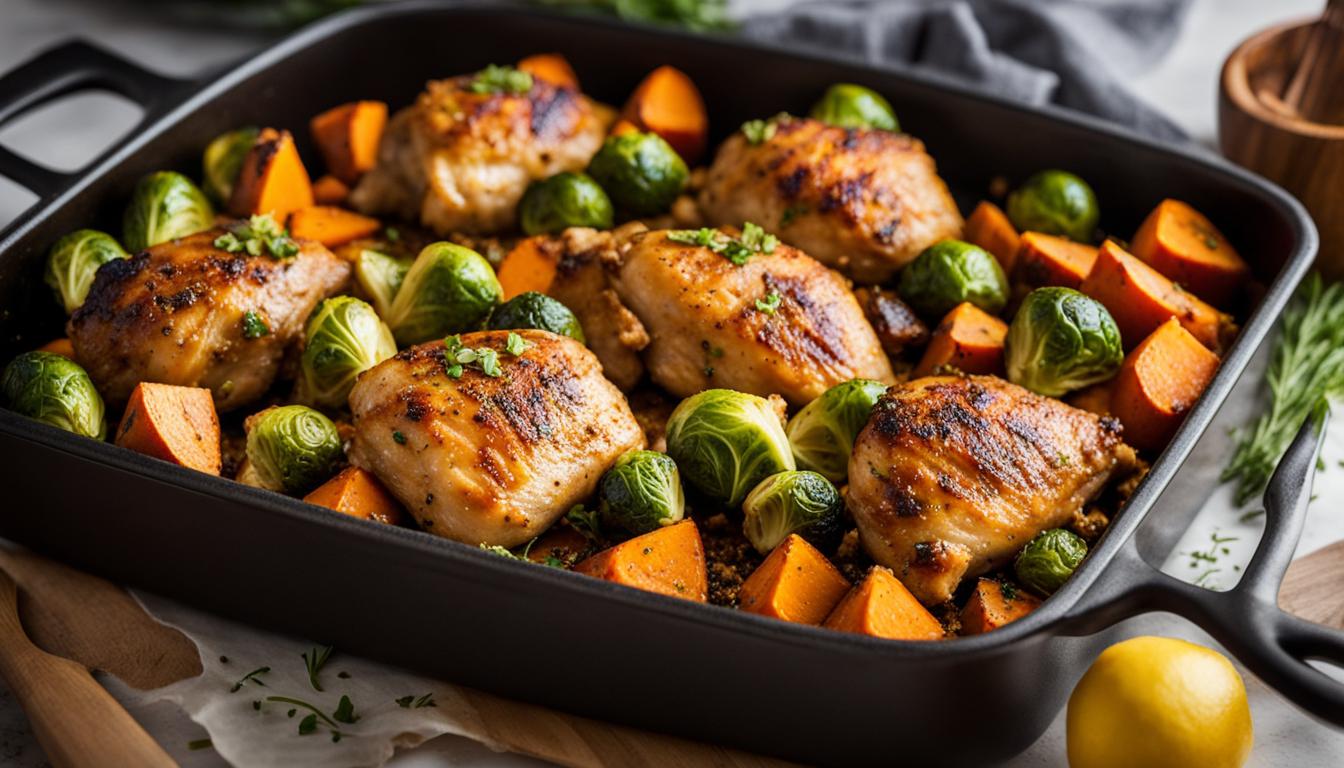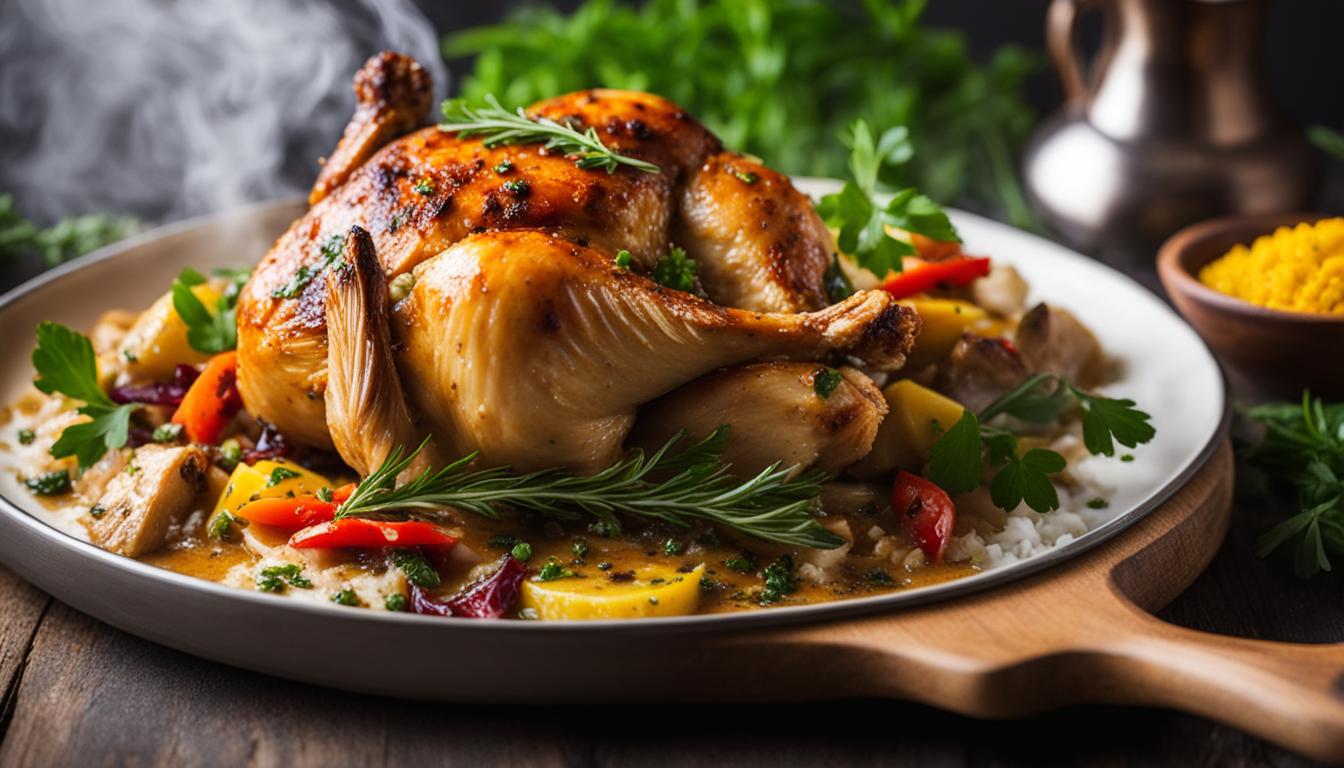When it comes to preparing a healthy and delicious meal, chicken is a versatile protein that checks all the boxes. But choosing the right cooking method can make all the difference in maintaining its nutritional value. In this article, we will explore a variety of healthy ways to cook chicken that will keep your taste buds happy and your body nourished.
Key Takeaways:
- Poaching, baking, steaming, sous vide, pressure cooking, and microwaving are all healthy cooking methods for chicken.
- Each method offers different benefits, such as moist and flavorful results, reduced fat content, and retained nutrients.
- Choosing the right cooking method and following proper food safety guidelines is essential for a delicious and nutritious chicken meal.
- It is important to cook chicken to the recommended internal temperature of 165ºF to ensure it is safe to eat.
- Experimenting with different cooking methods can help you discover new and exciting flavors while keeping your meals healthy.
Poaching: A Low-Fat Cooking Method for Moist and Flavorful Chicken
Poaching chicken is a wonderful technique that yields moist, tender, and flavorful results while keeping the fat content to a minimum. By cooking the chicken in a simmering liquid, such as broth or coconut milk, you can infuse subtle flavors into the meat while maintaining its natural juices.
To poach chicken, start by adding your seasoned chicken to a skillet or pot with your preferred cooking liquid. It could be a simple broth, a flavorful coconut milk, or any other liquid of your choice. Heat the pot over medium heat until the liquid begins to simmer. Once it reaches a gentle simmer, cover the pot and allow the chicken to cook until the internal temperature reaches 165ºF, ensuring it is fully cooked and safe to eat.
Poaching liquid can be repurposed into a delicious sauce by boiling it down slightly and thickening it with a suitable thickener like instant flour or cornstarch. This way, not only do you have poached chicken that is juicy and flavorful, but you also have a delightful sauce to complement the dish.
Try experimenting with different flavors and seasonings to create unique poached chicken recipes that are both healthy and delicious. The possibilities are endless, and your taste buds will surely thank you.
By incorporating poaching into your cooking repertoire, you can enjoy a low-fat method that produces moist and flavorful chicken. Give it a try and savor the delicious results!
Baking: A Healthy and Easy Way to Cook Chicken
Baking chicken is a simple and effective cooking method that requires little preparation. Not only is it a healthy way to cook chicken, but it also produces tender and juicy meat with crispy skin. To bake chicken, follow these easy steps:
- Preheat the oven to 350ºF.
- Season the chicken with some olive oil and spices of your choice. This can include salt, pepper, garlic powder, paprika, or any other preferred seasonings.
- Place the seasoned chicken in a baking pan with vegetables, such as carrots, potatoes, or Brussels sprouts, to add flavor and nutrients.
- Cover the pan with foil or a lid to trap in the moisture and cook for approximately 90 minutes. The cooking time may vary depending on the size and thickness of the chicken pieces.
- Check the internal temperature of the chicken using a meat thermometer. The chicken is safe to eat when it reaches an internal temperature of 180ºF.
- Remove the foil or lid for the last 10-15 minutes of cooking to allow the skin to crisp up.
- Once the chicken is fully cooked, remove it from the oven and let it rest for a few minutes before serving.
Baking chicken at a moderate temperature allows it to cook slowly and evenly, resulting in moist and flavorful meat. Additionally, the juices from the chicken and vegetables combine to create a delicious natural sauce.
By baking chicken, you can enjoy a healthy and satisfying meal without the need for excessive oil or added fats. It is a versatile cooking method that can be used for various chicken cuts, including bone-in or boneless, skin-on or skinless.
Try different seasonings and vegetable combinations to add variety and flavor to your baked chicken dishes. Whether you prefer a classic herb and lemon combination or a spicy Cajun blend, baking allows you to customize your chicken to suit your taste preferences.

Next, we will explore another healthy cooking method for chicken – steaming.
Frying: Healthier Tips for Crispy Chicken
While frying is often associated with unhealthy cooking, there are ways to make it a healthier option when preparing chicken. By making a few modifications to the traditional frying method, you can still achieve the perfect crispiness without compromising on your health goals. Here are some tips for healthier frying:
- Remove the skin: Before frying the chicken, remove the skin to reduce the fat content. The skin is where most of the unhealthy saturated fats reside. By removing it, you can significantly lower the calorie and fat content of the dish.
- Switch up the coating: Instead of using traditional bread crumbs or batter, opt for a modified coating mixture that includes herbs and spices. This adds flavor without relying on excessive oil or fat.
- Oven-fry: For an even healthier alternative, try “oven-frying” the chicken. Coat it in a light layer of breadcrumbs or panko and bake it in the oven at 375ºF. This method produces crispy chicken without the added oil and fat of traditional frying.
By implementing these healthier frying techniques, you can enjoy the satisfying crunch of fried chicken while staying true to your commitment to a healthier lifestyle.
Example Recipe: Oven-Fried Lemon Herb Chicken
| Ingredients | Amount |
|---|---|
| Chicken breasts | 4 |
| Breadcrumbs or panko | 1 cup |
| Lemon zest | 1 tablespoon |
| Fresh herbs (such as thyme, rosemary, or parsley) | 2 tablespoons, chopped |
| Salt and pepper | To taste |
| Olive oil | 2 tablespoons |
1. Preheat the oven to 375ºF.
2. In a shallow dish, mix together the breadcrumbs or panko, lemon zest, fresh herbs, salt, and pepper.
3. Dip each chicken breast into the breadcrumb mixture, pressing firmly to coat evenly.
4. Place the coated chicken breasts on a baking sheet lined with parchment paper.
5. Drizzle olive oil over the chicken breasts to help them brown and crisp in the oven.
6. Bake for 25-30 minutes or until the internal temperature reaches 160ºF, flipping the chicken halfway through cooking for even browning.
7. Remove from the oven and let the chicken rest for a few minutes before serving.
Enjoy this healthier version of crispy chicken with a side of steamed vegetables or a refreshing salad for a well-rounded and nutritious meal!
Steaming: A Quick and Nutritious Cooking Method for Chicken
Steaming is a high-temperature cooking method that preserves the moisture and nutrients of chicken. It is one of the healthiest ways to cook chicken, as it requires minimal added fat and keeps the chicken tender and flavorful.
To steam chicken, you can use a steaming basket or a steam-assisted hybrid oven. Place the chicken on the steaming rack and add some aromatic herbs or spices for extra flavor. Steaming creates a gentle cooking environment that prevents the chicken from drying out, resulting in a moist and tender texture.
Steam chicken for approximately 15-20 minutes or until it reaches an internal temperature of 165ºF. This ensures that the chicken is fully cooked and safe to eat. Steaming is particularly beneficial for people looking to reduce their calorie and fat intake, as the high temperatures also help melt away excess fat on the chicken.
Not only does steaming help retain the natural flavors of the chicken, but it also preserves its nutritional value. The slow cooking process preserves the chicken’s vitamins, minerals, and proteins, making it a nutritious choice for anyone striving for a healthy lifestyle.

Steamed chicken can be enjoyed on its own, added to salads, or used in various recipes. Its versatile nature makes it a great option for incorporating lean protein into your diet. Try steaming chicken breasts, thighs, or even a whole chicken for a satisfying and healthy meal.
Sous Vide: A Precise and Healthy Cooking Method for Chicken
Sous vide is an innovative cooking technique that offers precise temperature control, resulting in perfectly cooked chicken every time. In this method, the chicken is vacuum-sealed in a food-grade plastic pouch and cooked in a water bath at a specific temperature. The sealed pouch ensures that the chicken retains its moisture and flavor, while the gentle cooking process ensures even cooking throughout.
To cook sous vide chicken, start by seasoning the chicken with your desired herbs and spices. Place the seasoned chicken in a vacuum-sealed bag, ensuring that it is properly sealed to prevent any air from entering. Next, preheat a water bath to the desired temperature, typically around 140ºF (60ºC) for chicken.
Once the water bath reaches the desired temperature, carefully lower the bagged chicken into the water and ensure it is fully submerged. Cook the chicken for 1-3 hours, depending on the thickness and size of the chicken breasts or pieces. The long cooking time allows for tenderizing and flavor infusion.
Sous vide cooking offers several health benefits. Firstly, it minimizes nutrient loss that can occur with other cooking methods, as the chicken is sealed in the pouch and cooked in its own juices, preserving its natural flavors and nutrients. Secondly, the low and consistent temperatures reduce the formation of potentially harmful compounds like heterocyclic amines (HCAs) and polycyclic aromatic hydrocarbons (PAHs).
The result of sous vide cooking is tender, succulent, and flavorful chicken that is cooked to perfection. Whether you’re cooking chicken breasts, thighs, or even a whole chicken, sous vide ensures that every part is evenly cooked and retains its moisture.
Why Choose Sous Vide?
Sous vide cooking offers several advantages over traditional cooking methods:
“Sous vide cooking delivers consistently delicious results, offering chefs and home cooks precision, convenience, and a unique dining experience.” – Chef John, Cooking Expert
- Precise Temperature Control: Sous vide allows you to cook chicken to your desired level of doneness by setting the water bath to the exact temperature. This precision eliminates the risk of undercooking or overcooking.
- Enhanced Flavors: The vacuum-sealed pouch locks in the natural juices and flavors of the chicken, resulting in a more intense and delicious taste.
- Tender and Moist Texture: The gentle and even cooking process of sous vide ensures that the chicken remains tender, juicy, and full of moisture.
- Time-Saving: While sous vide cooking takes longer than some other methods, it requires minimal hands-on time and allows you to multitask while the chicken cooks. You can also prepare sous vide chicken in advance and finish it quickly when needed.
- Consistent Results: With sous vide, you can achieve consistent results every time, making it perfect for entertaining or when you want to impress your guests with a perfectly cooked chicken dish.
Comparing Sous Vide with Other Cooking Methods
| Cooking Method | Benefits | Drawbacks |
|---|---|---|
| Sous Vide | Precise temperature control, enhanced flavors, tender and moist texture, consistent results | Longer cooking time, requires special equipment |
| Baking | Easy and convenient, crispy skin, low-fat cooking method | Possible dryness, longer cooking time |
| Poaching | Moist and flavorful, low-fat cooking method | Lacks crispy texture, longer cooking time |
| Frying | Crispy texture, quick cooking time | High in fat and calories, potential for overcooking |
| Grilling | Distinct smoky flavor, charred texture | Potential for dryness, risk of flare-ups |
Table: Comparing sous vide with other cooking methods for chicken.
Pressure Cooking: A Fast and Healthy Way to Cook Chicken
When it comes to cooking chicken, one method that stands out for its efficiency and speed is pressure cooking. This cooking technique uses high temperatures for a short duration, resulting in tender and flavorful chicken dishes that are ready in no time.
One of the main benefits of pressure cooking is that it reduces the production of harmful compounds such as heterocyclic amines (HCAs), polycyclic aromatic hydrocarbons (PAHs), and advanced glycation end products (AGEs). These compounds are formed when meat is cooked at high temperatures and can have negative health effects.
How to Pressure Cook Chicken
- Season the chicken with your favorite herbs and spices.
- Place the chicken in the pressure cooker with a little water to create steam.
- Cover the pressure cooker and cook on high pressure for about 20 minutes or until the chicken is cooked through.
Pressure cooking is known for its ability to retain the natural vitamins and minerals present in chicken. Unlike other cooking methods that may cause nutrient losses, pressure cooking preserves the nutritional value of the chicken, making it a healthy choice for you and your family.
Additionally, pressure cooking reduces cholesterol oxidation, which is beneficial for maintaining heart health. By using this cooking method, you can enjoy all the benefits of chicken without compromising on flavor or nutrition.

Pressure cooking is not only a fast and healthy way to cook chicken, but it also allows you to prepare a variety of delicious and nutritious meals. From flavorful chicken soups to tender chicken curries, the possibilities are endless with this versatile cooking method.
Pressure cooking retains the natural flavors and nutrients of the chicken, resulting in moist and delicious meals that are good for your health.
So why not give pressure cooking a try? It’s a convenient and efficient way to cook chicken, providing you with flavorful and nutritious meals in a fraction of the time.
Microwaving: A Convenient and Healthy Option for Cooking Chicken
Microwaving chicken is a quick and convenient cooking method that can save you time in the kitchen. It is a healthier option compared to traditional frying, as it requires little to no oil. Plus, microwaving helps retain the natural flavors and nutrients of the chicken.
When microwaving chicken, it is essential to cook it to the recommended internal temperature of 165ºF to ensure it is safe to eat. Cooking times may vary depending on the size and thickness of the chicken pieces. Boneless, skinless chicken breasts are ideal for microwaving as they cook evenly and quickly in this method.
To microwave chicken breasts, follow these simple steps:
- Place the chicken breasts in a microwave-safe baking dish.
- Cover the dish with a microwave-safe lid or microwave-safe plastic wrap to trap steam and aid in even cooking.
- Cook on high power for 4-5 minutes per side, or until the chicken reaches the desired internal temperature of 165ºF. You can use a meat thermometer to check for doneness.
- Let the chicken rest for a few minutes before serving to allow the juices to redistribute.
Note that microwaving chicken may result in a lack of crispiness on the surface. However, you can still achieve delicious and tender chicken by using marinades, spices, or rubs to add flavor. Additionally, you can finish the chicken under a broiler for a few minutes to achieve a crispy outer layer.
By microwaving chicken, you can have a healthy and satisfying meal on the table in no time. It is a convenient option for busy individuals or those looking for a quick and easy cooking method.
Key Nutrients in Chicken and How Cooking Methods Affect Them
Chicken is a true powerhouse when it comes to providing essential nutrients for your body. It delivers an abundance of protein, B vitamins, iron, potassium, selenium, and essential amino acids that are vital for maintaining overall health.
Protein is essential for tissue repair and maintaining muscle mass. It plays a critical role in supporting the immune system and promoting healthy hair, skin, and nails.
B vitamins are essential for the proper functioning of the nervous system and metabolism. They help convert food into energy and facilitate DNA production and repair.
Iron is necessary for the production of red blood cells and the transportation of oxygen throughout the body. It also supports cognitive function and helps prevent iron deficiency anemia.
Potassium is an electrolyte that aids in fluid balance, supports proper muscle function, and helps regulate blood pressure. It also plays a role in maintaining heart health.
Selenium is a powerful antioxidant that helps protect cells from damage caused by free radicals. It supports thyroid function, aids in DNA synthesis, and strengthens the immune system.
Essential amino acids are the building blocks of protein and are necessary for various bodily functions, including muscle growth and repair.
While chicken is a nutritious choice, the way you cook it can impact its nutritional content. Different cooking methods can affect the levels of nutrients and the fat content. Let’s take a closer look at how cooking methods can influence the nutrients in chicken:
“The cooking method you choose can significantly impact the nutritional content of chicken. It’s important to select cooking methods that maximize nutrient retention.”
The Effect of Cooking Methods on Chicken Nutrients
1. Steaming and Boiling: These gentle cooking methods help retain nutrients in chicken by minimizing nutrient loss to the cooking liquid. Steaming and boiling keep the moisture content intact while cooking the chicken thoroughly.
2. Frying and Grilling: These high-temperature cooking methods can increase the fat content in chicken. Frying involves submerging chicken in oil, which adds extra fat. Grilling can cause fat to melt away, leading to a leaner result. However, grilling may produce unhealthy compounds due to the direct exposure to high heat and flames.
3. Baking and Roasting: These methods use dry heat to cook chicken, resulting in flavorful and tender meat. Baking and roasting can help retain nutrients, although some loss may occur due to the longer cooking times.
4. Sous Vide: This precise cooking method involves vacuum-sealing chicken and cooking it in a water bath at a controlled temperature. Sous vide preserves nutrients and flavors while yielding tender and juicy chicken.
To illustrate the nutrient changes based on cooking methods, refer to the table below:
| Cooking Method | Nutrient Retention | Fat Content |
|---|---|---|
| Steaming | High | Low |
| Boiling | High | Low |
| Frying | Medium | High |
| Grilling | Medium | Low to High* |
| Baking | Medium | Low to Medium* |
| Roasting | Medium | Low to Medium* |
| Sous Vide | High | Low |
*The fat content can vary depending on the cooking technique, ingredients used, and preparation methods.
It’s important to note that while some nutrient loss may occur during cooking, chicken remains a highly nutritious protein source regardless of the cooking method. In addition to considering nutrient retention, it’s crucial to prioritize food safety by thoroughly cooking chicken to an internal temperature of 165ºF (74ºC) to eliminate potential risks of foodborne illnesses.

Cooking Times for Different Cuts of Chicken
The cooking time for chicken can vary depending on factors such as the weight, cut, and cooking method. It is important to ensure that chicken is cooked thoroughly to kill any bacteria or harmful pathogens, while still retaining its delicious flavor. Here are some general guidelines for cooking times:
Whole Chicken:
When cooking a whole chicken, it typically takes about 1¼ to 1½ hours to cook at 350ºF. It is important to use a food thermometer to ensure that the internal temperature of the chicken reaches 165ºF, indicating that it is fully cooked and safe to eat.
Boneless Chicken Breasts:
Boneless chicken breasts cook faster than whole chicken, usually taking about 20-30 minutes at 350ºF. However, cooking times may vary depending on the size of the chicken breasts and the cooking method used. It is always recommended to use a food thermometer to ensure the chicken reaches an internal temperature of 165ºF.
Drumsticks and Thighs:
Drumsticks and thighs are slightly larger cuts of chicken and may require a longer cooking time compared to boneless chicken breasts. It generally takes about 30-40 minutes to cook drumsticks and thighs at 350ºF. Again, it is crucial to use a food thermometer to check that the internal temperature reaches 165ºF to ensure the chicken is fully cooked.
Remember that these are just general guidelines, and cooking times may vary depending on the size of the chicken cuts, oven temperature, and personal preferences. Always rely on a food thermometer to ensure the chicken is cooked thoroughly and safe to consume.
“Cooking times for different cuts of chicken may vary, so it is essential to use a food thermometer to check the internal temperature for doneness.”
Conclusion
Cooking chicken in a healthy way is essential to retain its nutritional value and ensure food safety. There are several healthy cooking methods that result in moist and flavorful chicken. These methods include poaching, baking, steaming, sous vide, pressure cooking, and microwaving.
When handling chicken, it is crucial to follow proper food safety practices and cook it to the recommended internal temperature. This ensures that any bacteria or harmful pathogens are killed. By choosing the right cooking method and following proper techniques, you can enjoy delicious and nutritious chicken meals.
Remember to choose high-quality chicken and use fresh ingredients to maximize the flavors. Experiment with different seasonings and spices to create unique and tasty chicken dishes. Whether you prefer the convenience of microwaving or the precision of sous vide cooking, there is a healthy cooking method that suits your preferences and dietary needs. Enjoy the benefits of cooking chicken in a way that not only tastes great but also keeps you healthy!
FAQ
What is poaching, and why is it a healthy way to cook chicken?
Poaching involves cooking chicken in a simmering liquid, such as broth or coconut milk, which adds minimal fat while retaining moisture and flavor.
How do I bake chicken in a healthy way?
To bake chicken, season it with olive oil and spices, place it in a baking pan with vegetables, and bake it in the oven at 350ºF until the internal temperature reaches 180ºF.
Can I make fried chicken healthier?
Yes, you can remove the skin before cooking and use a modified coating mixture with herbs and spices. Another healthier option is to “oven-fry” the chicken by coating it in breadcrumbs or panko and baking it.
What is steaming, and why is it a nutritious cooking method for chicken?
Steaming involves cooking chicken using steam, which preserves moisture and nutrients. This results in a moist and tender texture, making it a healthier choice.
What is sous vide, and why is it a healthy cooking method for chicken?
Sous vide involves vacuum-sealing chicken in a plastic pouch and cooking it in a water bath at a specific temperature. It retains moisture and nutrients, producing tender chicken with a high mineral content.
How can I cook chicken quickly and healthily?
Pressure cooking is a fast and efficient method. Add seasoned chicken and a little water to the pressure cooker, and cook for about 20 minutes or until the chicken is done. It retains vitamins and reduces cholesterol oxidation.
Is microwaving a healthy option for cooking chicken?
Microwaving is quick and convenient for cooking chicken. However, it may burn the surface and dry out the meat. It is recommended for boneless, skinless chicken breasts and cooking them in a covered baking dish.
What key nutrients does chicken provide, and how does cooking method affect them?
Chicken is a nutrient-rich food, providing protein, vitamins, minerals, and essential amino acids. Cooking methods like steaming and boiling preserve the nutrients, while frying and grilling may increase fat content.
How long should I cook different cuts of chicken?
Cooking times vary based on weight, cut, and cooking method. Whole chicken takes 1¼ to 1½ hours at 350ºF. Use a food thermometer to ensure the chicken reaches an internal temperature of 165ºF.


